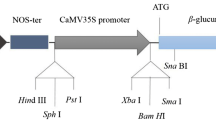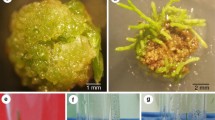Abstract
One of the important factors responsible for recalcitrance of maize tissue towards Agrobacterium-mediated transformation is the presence of 2,4-dihydroxy-7-methoxy-2H-1,4-benzoxazin-3(4H)-one (DIMBOA), an inhibitory metabolite found in maize cells. DIMBOA-resistant strains of Agrobacterium tumefaciens were used to transfer genes coding for GUS (β-glucuronidase) and NPTII (neomycine phosphotransferase II) in maize shoot apical meristems derived from 20 day-old seedlings and immature embryos. GUS expression was higher (21–34%) in the apical meristem and was dependent on the type of infecting strain and explant-age. The PCR analysis of selected tissues confirmed the presence of GUS gene in the transformed cells.
Similar content being viewed by others
References
Armstrong CL (1999) The first decade of maize transformation: a review and future perspective. Maydica 44: 101-109.
Bommineni VR, Walden DB, Greyson RI (1989) Recovery of fertile plants from isolated, cultured maize shoot apices. Plant Cell Tiss. Org. Cult. 19: 25-234.
Dong J, Teng W, Buchholz WG, Hall TC (1996) Agrobacterium mediated transformation of Javanica rice. Mol. Breeding 2: 267-276.
Grimsley N, Ramos C, Hein T, Hohn B (1988) Meristematic tissues of maize plants are most susceptible to agroinfection with maize streak virus. Bio/Technology 6: 185-189.
Hansen G (2000) Evidence for Agrobacterium-induced apoptosis in maize cells. MPMI 13: 649-657.
Hansen G, Das A, Chilton M-D (1994) Constitutive expression of the virulence genes improves the efficiency of plant transformation by Agrobacterium. Proc. Natl. Acad. Sci. USA 91: 7603-7607.
Hiei Y, Ohta S, Komari T, Kumashiro T (1994) Efficient transformation of rice (Oryza sativa L) mediated by Agrobacterium and sequence analysis of the boundaries of the T-DNA. Plant J. 6: 271-282.
Ishida Y, Saito H, Ohta S, Hiei Y, Komari T, Kumashiro T (1996) High efficiency transformation of maize (Zea mays L) mediated by Agrobacterium tumefaciens. Nat. Biotechnol. 14: 745-750.
Jefferson RA, Kavangh TA, Bevan MW (1987) GUS fusion: β-glucuronidase as a sensitive and versatile gene fusion marker in higher plants. EMBO J. 6: 3901-3907.
Komari T, Hiei Y, Ishida Y, Kumashiro T, Kubo T (1998) Advances in cereal gene transfer. Curr. Opin. Plant Biol. 1: 162-165
Owens LD, Smigocki AC (1988) Transformation of soybean cells using mixed strains of Agrobacterium tumefaciens and phenolic compounds. Plant Physiol. 88: 570-573.
Potrykus I (2001) Golden rice and beyond. Plant Physiol. 125: 1157-1161.
Pret'ová, Obert B, Wetzstein HY (2001) Leaf developmental stage and tissue location affect the detection of β-glucuronidase in transgenic tobacco plant. Biotechnol. Lett. 23: 555-558.
Rashid H, Yokoi S, Toriyama K, Hinata K (1996) Transgenic plant production mediated by Agrobacterium in Indica rice. Plant Cell Rep. 15: 727-730.
Sahi SV (1992) Effect of DIMBOA, a corn metabolite, on growth and virulence gene induction of Agrobacterium tumefaciens, and an attempt to transform corn cells by Agrobacterium. Ph.D. Thesis. Raleigh, NC: North Carolina State University.
Sahi SV, Chilton MD, Chilton WS (1990) Corn metabolites affect growth and virulence of Agrobacterium tumefaciens. Proc. Natl. Acad. Sci. USA 87: 3879-3883.
Sahi SV, Gagliardo RW, Chilton MD, Chilton WS (1994) A thin layer chromatographic technique for detecting inducers of Agrobacterium virulence genes in corn, wheat and rye. Plant Cell Rep. 13: 489-492.
Sambrook J, Fritsch EF, Maniatis T (1989) Molecular Cloning: A Laboratory Manual. Cold Spring Harbor, NY: Cold Spring Harbor Laboratory.
Shen WH, Escudero J, Schlappi M, Ramos C, Hohn B, Koukolikova-Nicola Z (1993) T-DNA transfer to maize cells: histochemical investigation of β-glucuronidase activity in maize tissues. Proc. Natl. Acad. Sci. USA 90: 1488-1492.
Tingay S, McElroy D, Kalla R, Fieg S, Wang M, Thornton S, Bretell R (1997) Agrobacterium tumefaciens-mediated barley transformation. Plant J. 11: 1369-1376.
Vancanneyt G, Schimdt R, O'Connopr Sanchez A, Willmitzer L, Rocha-Sosa A (1990) Construction of an intron containing marker gene: splicing of the intron in transgenic plants and its use in monitoring early events in Agrobacterium-mediated plant transformation. Mol. Gen. Genet. 220: 245-250.
Zhang Jian, Xu RJ, Elliott MC, Chen DF (1997) Agrobacteriummediated transformation of elite Indica and Japonica rice cultivars. Mol. Biotechnol. 8: 223-231.
Author information
Authors and Affiliations
Rights and permissions
About this article
Cite this article
Mohamalawari, D., Sharma, N.C., Cristae, P. et al. Transformation of maize by 2,4-dihydroxy-7-methoxy-2H-1,4-benzo- xazin-3(4H)-one resistant Agrobacterium strains. Biotechnology Letters 24, 197–203 (2002). https://doi.org/10.1023/A:1014105225659
Issue Date:
DOI: https://doi.org/10.1023/A:1014105225659




